Origins
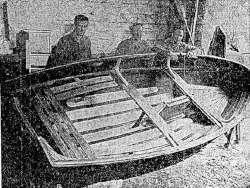
The first clinker Rankin dinghy was built in the early 1960s. The earliest solid date we have comes from an Evening Echo article of 10 July 1962 which indicates that the Rankin was already in production by then (fig.1). However, the origins of the design date back to the early 1950s when a cold-moulded prototype that gave birth to the clinker class was built by Eddie Twomey (1917-1976) and Eric Rankin (1926?-1975?). Eddie, another Cobh man, was a wooden boat and sailing enthusiast who introduced Eric to boat building in the 1940s.
The story of the prototype and its construction are outlined here. In all, only three of the prototype design were built and they are still going strong today.
Eddie Twomey left a number of artifacts including line plans, half-model, notes and photos and Ida Hadley (Eric’s sister) supplied what relevant photos she had to the group. Unfortunately, very little survives from the Rankin Lynch’s Quay workshop and the chronology of building the Rankin clinker production boats is more difficult to establish.
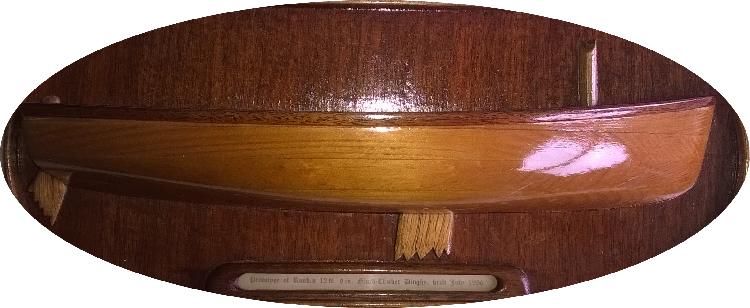
Timeline
| 1945 | Eddie Twomey designs and builds Dairne, a variant of the National 12, which subsequently became known as the T class in Cove Sailing Club. Ten of the class were built in total over the next four years. |
| 1946 | Eddie Twomey introduces Eric Rankin, about nine years his junior, to boat building by helping him build his first boat, a T class called Mur Too. |
| 1947 | Eddie builds a second T class boat called Cliodhna. |
| 1948 | Eric builds a second T class boat called Swift. |
| 1949 | Eric may have built a third T class boat called Sheldrake on commission for Harmon. |
| ca 1949 | Eric sets up a boat workshop at Batesons Farm, Bellevue, Cobh. |
| ca 1952 | Eric moves workshop to Lynch’s Quay, Cobh. |
| 1955 / 56 | Eddie and Eric collaborate on a new design, a cold-moulded dinghy. Eddie builds Fiona. Eric builds what is now called Freedom V on commission for Dr Reynolds. This design is later adapted by Eric in the 1960s to produce the clinker Rankin. The prototype completion date is July 1956. |
| 1956 | Eric builds his first 5o5, WOW, for Maher; she is completed in late August 1956. |
| 1957 | Eric builds two more first 5o5s: Three Star for O’Meara, Thalia for Hennessy (CSC). |
| 1957 | Eric closes workshop and moves to the UK. He spent time at three boatyards: Fairey Marine Yard, Southampton, South Devon Boatbuilders Company, Dawlish and Morgan Giles, Teignmouth. |
| 1959? | Eric returns to Cobh and reopens workshop at Lynch’s Quay. |
| 1960 | Eric with brother David, builds the third cold-moulded boat Helga and exhibits her at the Dublin Boat Show winning 2nd prize in the professional builders category. |
| ca 1960 | Eric adapts the forms of the cold-moulded dinghy, adopting a rounder, beamier shape to build the first of the glued plywood clinker design. This may be the Moynihan family’s Kevdec. |
| 1960s - 1980s | The clinker design is in production (over 80 are built) in various forms (with/without daggerboard case, sailing rigs (e.g., Bermudan, Gunter), seating arrangements, etc). |
| 1997 | Having secured the clinker forms at auction on the close of the Rankin workshop in the late 1980’s, local woodwork teacher, Dave O’Keeffe, builds his own Rankin. |
| 2021 | Dave O’Keeffe leads on the building of a new Rankin, initiating Owen O’Connell in the craft of boat building. |
T Class
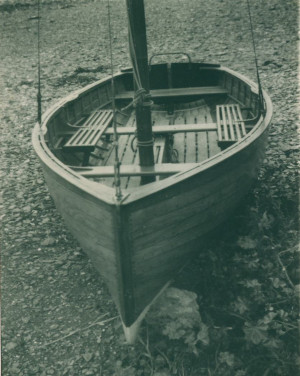
In a short newspaper profile in 1960 Eric Rankin states that he got into the work of professional boat building through building Cove Sailing Club (CSC) T Class boats. Eddie Twomey had planned and built the first T Class dinghy called Dairne in 1945. Other enthusiasts built their own boats, several helped by Eddie, we understand. In particular, Eddie helped Eric build his first boat called Mur Too in the Rankin family home at King’s Terrace.
CSC introduced a T Class to its ranks in 1947, ten boats in total being built by 1949. Eddie builds two, Eric two (or possibly three). Other local sailors, JJ O’Mahoney, P Cotter, Keb Sealy, N Casey and TA O’Sullivan also built boats.
Rankin workshop
By the late 1940s, Eric has set up as a professional boat builder, opening a workshop in Cobh, first at Bateson’s farm, Bellevue and later at Lynch’s Quay. He is established at Lynch’s Quay at the latest by 1952 when Joe Stromsoe begins his apprenticeship there.
The prototype
Among the items left by Eddie relating to the prototype, there are a half-model with the prototype build date (fig.2), a lines plan (fig.4) and a comparison of the cost of traditional building (planking) vs cold-moulding (fig.6). The half-model wall mount was made by Eddie for his cousin, Paddy Russell, who owned a Rankin.
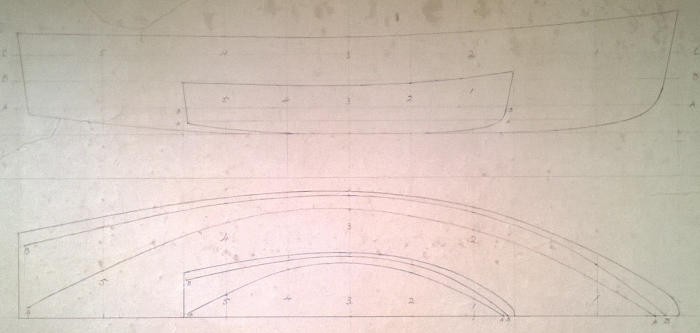
Construction methods
The Rankin is built using the clinker/lapstrake method in which plywood planks overlap each other and are secured with glue. However, the prototype of the Rankin design used a very different construction method, that of cold-moulding, in which a series of veneers/laminates is shaped on a mould and glued together to form the hull. Fairey Marine in the U.K., capitalising on their experience building wood-laminate wartime aircraft (as Fairey Aviation Company) marketed one of the first mass-produced laminated dinghies in 1946, the Firefly, an Uffa Fox design. Because of the limitations of the glues at the time, however, those dinghies were hot-moulded by being placed in a large autoclave to enable the glue to set at the higher temperature and pressure required. By the 1950’s new glues that would set at room temperature and with sufficient pressure provided by stapling the veneers together became available and this put the technique within reach of the home builder.
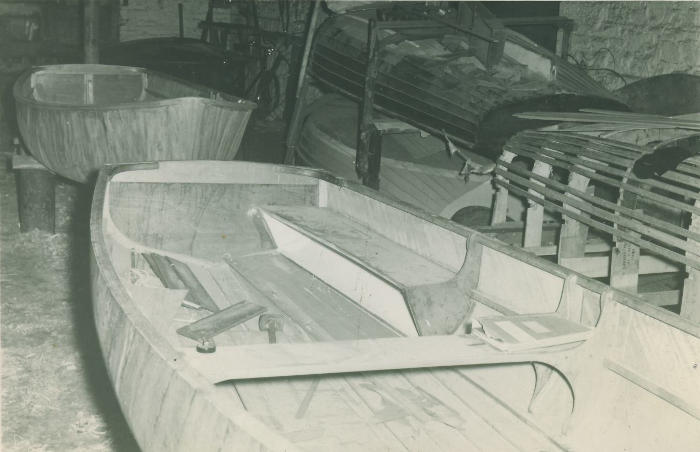
Cold-moulding
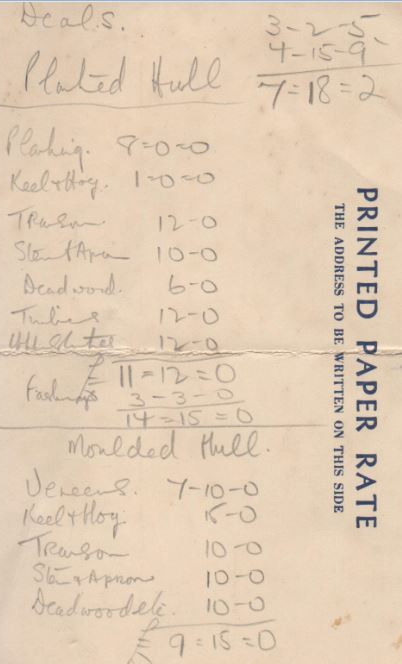
The choice of cold-moulding is interesting. Costing was hardly a factor. A back-of-the-envelope estimate (fig.6) of planked vs moulded by Eddie indicates that moulded was somewhat cheaper but the cost does not include the glue. Eddie would certainly have been aware of new building techniques, e.g., a note of his, dated 9 May 1947, in reference to the hot-moulded Firefly around the time of its introduction states “skin 3/16” resin bonded moulded ply”. However, the likely impetus for choosing cold-moulding was the introduction of the cold-moulded 5o5s in 1954. This international class rapidly took off, with workshops like George Bush’s in Ringaskiddy importing hulls for finishing. Cobh man Joe Stromsoe who was an apprentice in Eric’s workshop from 1952 to 1957 remembers accompanying Eddie and Eric on a somewhat alarming passage by sail over to Ringaskiddy to George Bush’s workshop to see the 5o5s being finished there.
In contrast, over 1956-57, Eric actually built three 5o5s from scratch. These were Wow for John Maher, Thalia for international rugby player, PJ O’Meara, and Three Star for H.O. Hennessy. Joe Stromsoe also recalls O’Meara visiting the workshop with Ted Crosbie who already had his own 5o5 (from George Bush’s workshop in Ringaskiddy).
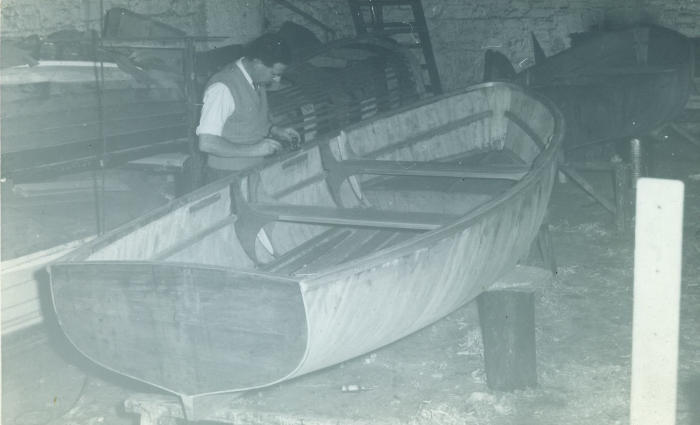
It was J. Clayton Love who introduced the 5o5 class to Ireland. His boat, Miss Betty II made her debut in a race from Crosshaven to Aghada on 24th April 1955. By 1957 there were four in the class in Cork Harbour, the latest being O’Meara’s Three Star. By July 1957, the 5o5 class in the IDRA championships in Crosshaven included 12 entries, seven being Irish and five from Cork.
We know that Eric completed the Maher boat WOW in August 1956, a month after the completion of the prototypes, because the Cork Examiner, 23rd August 1956, had a piece on the Maher 5o5 indicating that she was the first one built in the country:
A boat … now lying on Robinson’s Slip in Cobh … is the 5-0-5 WOW built to the order of those well known Cork Harbour sailing brothers Messrs R. and M. Maher by the young Cobh boat-builder Mr. Eric Rankin in his workshops on Lynch’s Quay … The boat, first of its class to be built in Ireland …
In photos of the Lynch’s Quay workshop around 1955/56 the Fiona and Reynolds boat are shown with a 5o5 mould in the background suggesting that 5o5 construction was occurring concurrently (although why the WOW was launched late, missing the 1956 sailing season, is hard to explain). In another photo, two 5o5s are under construction simultaneously with no sign of the Rankin prototypes. We can surmise that these are the O’Meara and Hennessy boats, under construction in 1956/57 as we know O’Meara’s boat made her debut in 1957.
This adoption of the cold-moulding technique in 1955/56 must surely put the prototypes amongst the first cold-moulded boats to be built in Ireland.
UK sojourn
In late 1957 (as confirmed by Joe Stromsoe and Ida Hadley) Eric moved to England to work. He spent time at three workshops: Fairey Marine Yard, Southampton, South Devon Boatbuilders Company, Dawlish and Morgan Giles, Teignmouth. Details become scarce at this stage - about how long Eric was away - but he did resume building at Lynch’s Quay by 1960. In that year, with his brother David, he built the third of the cold-moulded dinghies and an 8ft yacht tender version. These were displayed in Dublin during Easter week at a boat show that was raising funds to send a yachting team to the Olympic Games. The Rankins won 2nd prize in the professional builders category. This third boat became Eric’s own boat and was named Helga.
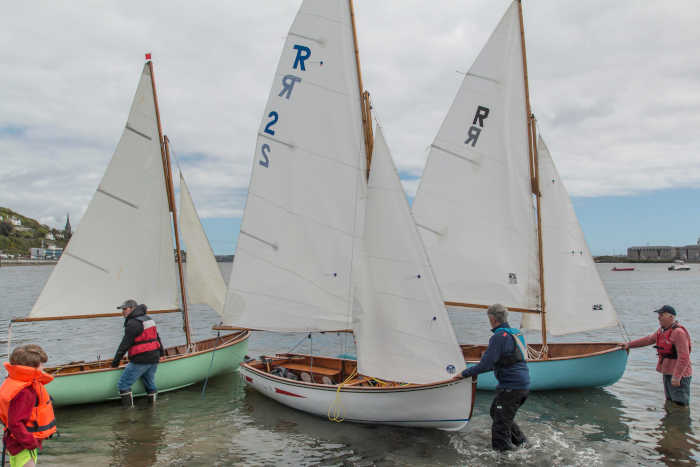
Only three full sized cold-moulded dinghies were made although Eric may have built some additional boat tenders. The three dinghies are still going strong after 60+ years (fig.8), the Fiona with Eddie Twomey’s grandson, James Burke, the Helga with Owen O’Connell, and the Reynolds boat (now named Freedom V), recently bought and beautifully renovated by John Horgan. It must be said that without the expert sleuthing of Maurice Kidney, the Helga and Reynolds boat might not be back in Cobh.
The gluelap era
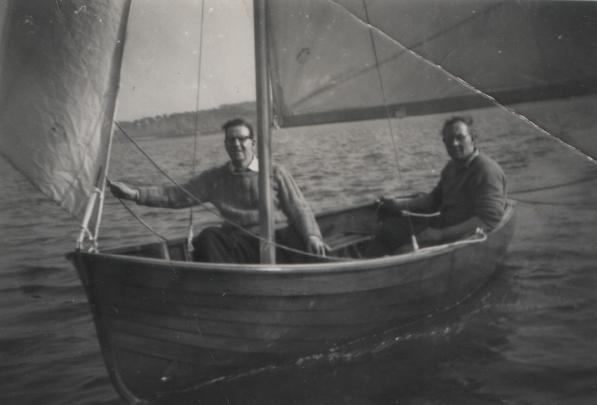
Eric may have been incentivised to explore methods of “mass production” based on what he experienced in the UK boat yards which led to the clinker version of what subsequently became the standard Rankin dinghy. The clinker version would be less labour intensive to produce than the cold-moulded one. In any case, Eric adapted the forms of the cold-moulded dinghy to make the clinker one (as related to Éamonn Twomey by his father Eddie). Eddie appears to have still been involved in the testing and rigging of the new design (fig.9,10) but hereon fades out of the picture.
The new revised design proved to be popular and over the next three decades the Rankin workshop headed by Eric and later David and with the assistance of several associates and apprentices produced some 80+ boats.
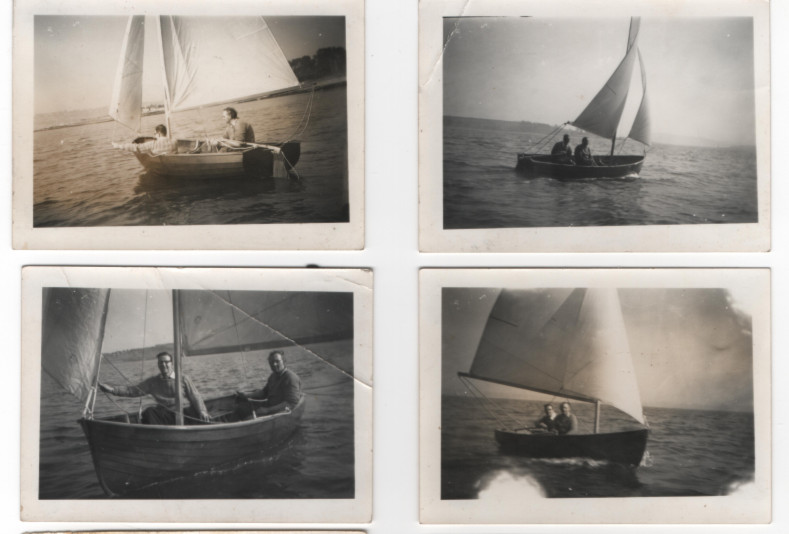
Acknowledgements
Thanks to Owen O’Connell for sharing newspaper archive search results, Dermot Burns (archivist, RCYC), for pinning down some 5o5 dates and Conor English for providing contacts. And a special thank you to Ida Hadley for sharing her memories of brother Eric’s early days in boat building and to Joe Stromsoe for sharing his reminiscences of his apprenticeship in Eric’s workshop on Lynch’s Quay.